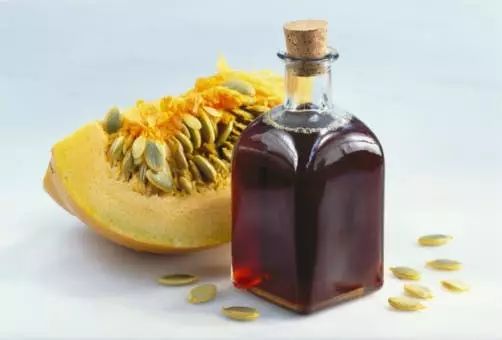
Crimson, light green, it's all it.
can you see two different colors for the same liquid? Pumpkin seed oil can do that.
in some parts of Central Europe, people like to season salads with oil extracted from pumpkin seeds. When sprinkling a dish with pumpkin seed oil, people will observe the unusual properties of this liquid: when pumpkin seed oil is placed in a bottle, it shows a beautiful crimson:
and if it is covered with a thin layer, you will see that it shows a light green hue:
(I took both of the above pictures, do you see the light green on the edges? )
below is a thin to thick layer of pumpkin seed oil. I took the colors on both sides and can see that pumpkin seed oil is really not as dark as the thickness of the liquid increases. Thin layers are greener, while thicker liquids have more red ingredients:
this property is called "Dichromatism". Pumpkin seed oil and bromophenol blue solution are classic examples of dichroism. Special research papers have discussed the dual color characteristics of pumpkin seed oil, which pointed out that when the thickness of pumpkin seed oil is below 0.7mm, it will look light green, and when it exceeds this thickness, it will look reddish.
this color change can be explained by the absorption spectrum of pumpkin seed oil (for more intuition, only the transmission spectrum, which is complementary to the absorption spectrum) and the photosensitive mode of the human eye.
visible light is absorbed when it passes through pumpkin seed oil, and the rest of the transmission after absorption is the key to determining the color. The picture below shows the transmission spectrum of a thin layer of pumpkin seed oil. you can see that there are two peaks, the red peak is higher but narrower, and the green peak is shorter but wider, with a lot of yellow and blue light on both sides.
if you only compare the height, it seems that the red transmitted light wins, but in addition to the real green light, the yellow light and blue light on both sides will also appear green in the human eye. As a result, people finally see that the color is still relatively green.
and the following picture shows the transmission spectrum of the thicker pumpkin seed oil layer. At this time, because the liquid is deeper and absorbs more light, both "peaks" decrease significantly. At this time, the green light transmission peak has dropped to a very low, yellow and blue light is almost gone, but at this time there is still a lot of red transmission light. Therefore, at this time, there is no doubt that red light accounts for the peak in the transmitted light, so the thicker pumpkin seed oil looks crimson.
theoretically, the solution with both "high and narrow" and "short and wide" peaks in the transmission spectrum of visible light should have dichroic potential, but the actual effect is not necessarily as obvious as pumpkin seed oil.
by the way, in addition to dichroism, pumpkin seed oil can be said to have the third hidden color-fluorescence. Because it contains prochlorophyll, pumpkin seed oil has bright orange-red fluorescence when observed under UV light:
Do you want to buy the flattering non traditional wedding dresses and help bring out the charm in your figure? Check the New Arrivals and the latest word in fashion.
(this picture is a video taken from Steve Mould, the effect of my own shot is not very good.)
of course, if you are observing fluorescence, you don't have to buy a bottle of pumpkin seed oil. For related small experiments, see: small experiments: adjusting the fluorescent color of a bowl of pumpkin seeds
may be the most fun cooking oil. Dark red is very beautiful to the light.
reference:
Spectrum is from: https://en.wikipedia.org/wiki/Dichromatism
A related paper: https://www.ncbi.nlm.nih.gov/pubmed/17534588